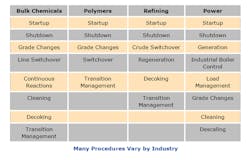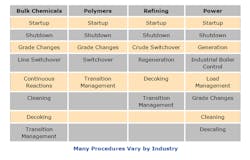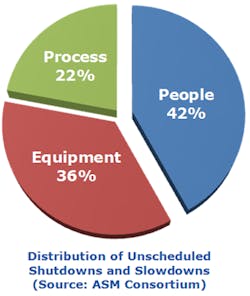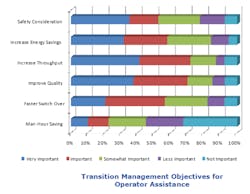Use Automation To Reduce Operator Stress, Increase Plant Safety
Procedures are everywhere; and nowhere is this more obvious than in the process industries. Many like to refer to the process industries as being largely “continuous,” but this – in fact – is a misrepresentation. The state of process facilities constantly changes. Whether starting up, shutting down, changing grades or in the middle of a turnaround, a plant operates by procedures and transitional states. These can either run smoothly to pro-vide superior plant performance and a safe and orderly start-up/shutdown/transition, or result in costly unplanned shutdowns, incidents, lost product and lost opportunities.
[pullquote]
Procedures are a predetermined group of tasks that must be completed in a set order and in a consistent manner to achieve a desired goal or result. Startups, shutdowns, and grade changes are probably the most common. Of course, procedures vary in terms of complexity and duration and requirements for plant procedures vary for each industry, but the common denominator is that plants cannot operate without them.
Manual, Prompted and Automated
Today, operational procedures fall into three primary categories: manual, prompted and automated. Some procedures consist of all three.
With manual procedures, operators perform the necessary actions either guided by their own years of experience or by a standard operating procedure (SOP) manual. As one might expect, the consistency with which manual procedures are performed can vary greatly depending upon the amount of experience and attention paid by the individuals carrying out the procedures. In some cases, the written procedures haven’t been kept current, forcing workers to rely more on personal experience than intended. Manual record keeping, which often accompanies manual procedures, can also vary in its effectiveness and quality. However, even when electronic records are created for manual procedures, their quality can also vary de-pending upon how well they were entered into the system and only reflect the procedures purported to be carried out. Often, there is no way to verify that the manual procedures followed were, in fact, consistent with printed SOPs.
Prompted operational procedures go one step further. Prompted procedures are implemented in the process automation system. The system asks the operator to acknowledge that each manual step has been completed successfully to be able to continue. Prompted procedures make it easier to keep electronic records, verify that procedures were followed correctly, and can help decrease transition times and procedural variability.
Like prompted operational procedures, automated procedures are implemented in the process automation system. The difference here is that automated procedures will go through an entire operational sequence before stopping, unless either the operator or system intervene on an exception basis. Automated procedures can provide even greater reductions in variability and transition time. Automated procedures are the equivalent of having the best operator on the board all the time.
Many industries have been using prompted or automated procedures for some time. The batch industries, such as life sciences and food & beverage, have been using the ISA88 standard for years. This defines a modular approach to batch automation and batch procedures. In the continuous process industries, however, prompted and automated procedures are not yet well-established. With the increasing awareness of the ISA106 standard, however, which is the process industry equivalent of ISA88, this should gradually change. Traditionally, many process industry end users have considered operations such as starting up and shutting down a coker unit or cat cracker in a refinery (or the refinery as a whole) to be a craft or an art form that relies heavily on experience and knowledge of the particular plant and its quirks. But times and technology have changed.
This is not to say that automated procedures are unknown in the continuous process industries. Many companies have implemented sequence logic that allows procedures to be automated. However, these have been done largely in an ad hoc manner, often using poorly documented, custom programming methodologies that are difficult to troubleshoot and can become cumbersome when it is time to upgrade the automation infrastructure. This ad hoc approach also carries a high cost of ownership, since the end user must maintain the procedure. Changes made to the code over time can create a tangled mass of “spaghetti code” that can be difficult, if not impossible to translate.
Many end user companies in the process industries today are also the result of mergers and acquisitions. This often means that many system platforms and unstructured code implementations have accumulated over the years. Clearly, this is not a sustainable way to do business. As a result, more and more end users are now standardizing their approaches.
Real-World Operations Call For Modular Procedural Automation
Overcoming the issues associated with custom approaches based on proprietary code requires a standard, modular approach to automated procedures. Modular applications help make functions more manageable and standardized across plants, sites, and the entire business enterprise. A standardized approach reduces engineering costs, labor costs, and total cost of ownership.
Modular procedures go beyond the software and systems upon which these procedures are implemented; however, not all procedures can be auto-mated. Automation users must strike the right balance between manual, prompted, and automated procedures. Users should use a consultive methodology when implementing procedural automation, with an eye toward improving operations and reliability in the plant. Specific benefits include increased safety, energy savings, increased throughput, improved quality, faster transitions, less waste, and the ability to capture knowledge from a rapidly transitioning workforce. Modular procedural automation will provide a foundation for safe and effective plant operations moving forward.
The process industries face many daunting issues. These include keeping safety, health, and environment at the forefront; an aging workforce; improving availability; managing quality; and dealing with increased operator workload. Distracted operators make mistakes. Operational error continues to be the single biggest reason for unscheduled shutdowns.
Enhancing Human Reliability
In many process industries, the overarching objective is to improve utilization. This cannot be achieved without reducing unplanned downtime. Research shows that the largest reason for unscheduled downtime is operational or human error. According to a study by the ASM Consortium, this accounts for approximately 42 percent of the unscheduled shutdowns in the process industries. Of that 42 percent, 14 percent relates directly to procedural errors. When researching the role of operators in the refinery of the future, several major operating companies concluded that they could address this by using a higher-level perspective on the entire production operation, one that supports intervention-by-exception to relieve the operator of many previously manually performed tasks and freeing them to perform more value-adding activities.
ARC Advisory Group has identified procedural automation, along with alarm management and an operational perspective, as a crucial process automation system function contributing to an environment of flawless operation. With procedural automation, the know-how and operating level of experienced operators can be incorporated into automatic sequences and used to standardize operating methods and improve the efficiency of all operators. Think of it as having the most experienced and most effective operator on the board all day, every day.
Humans are good at ad hoc intervention and non-linear reasoning. They do best when empowered with an overall production cycle perspective. Machines and automation are good at repetitive functions, steady-state functions and transition management. With automated procedures, today’s highly capable automation technology can support a consistent environment of unbroken, precise execution; linear reasoning; and best practices.
Increasing Plant Safety
As previously stated, modular procedural automation also increases process safety. Accidents continue to occur in many manufacturing facilities, even after installing the safety systems and other safety protections that had previously been considered adequate. Faced with an abnormal situation, operators must deal with a flood of information and, often, a flood of alarms. It can be difficult to sort through all the noise to get to the right data and make a good decision in a crisis. Procedure-based recovery from abnormal situations is faster and more reliable than recovery based on random operator knowledge — even when those operators are seasoned experts.
Modular procedural automation could also prevent abnormal events from occurring in the first place. Several major incidents in the past few years were due or exacerbated in part by plant personnel that did not follow proper operating procedures while under pressure. Additionally, operators and maintenance personnel do not always follow standard operating procedures when required to execute them manually. For every incident that occurs due to poor procedural operations, there are likely ten near misses.
Overcoming Constrained Worker Resources
Finding experienced personnel is a challenge across the process industries. The retiring wave of “baby boomers” in North America and the shortfall of qualified engineers in Asia and other parts of the world create a skilled labor shortage. This will drive growth in demand for services and more sophisticated forms of automation.
In an interview, an executive at a major refining company stated the company had lost 2,500 years of experience recently when 100 operators retired at one site. As further evidence, a team at a major chemical company analyzed its plant demographics and found that one of its largest plants had lost 75 percent of its operating staff to retirement at the end of 2009. An-other major refiner must fly its experienced people to various sites all over the US to augment the existing workforce during startups. Yet another re-fining company must rehire retired workers to do unit startups because it does not have enough people left on site that know how to perform these procedures. A major chemical company recounted pulling operators out of retirement to be able to start up one of its units.
Implementing modular procedural automation can help capture the knowledge of skilled employees before they retire or are laid off. Automation, in general, can be a powerful tool to institutionalize tribal knowledge. Recent research shows that up to 42 percent of all corporate knowledge is stored in employees’ brains.
Most firms continue to operate with lean technical staffs, but technological complexity is increasing. The timely flow of information, data, and knowledge is more important than ever in the process industries. This downward trend in staffing and the increased demand for accurate, real-time information will translate into additional systems and higher, more sophisticated levels of automation being applied, including modular procedural automation. Tomorrow’s smaller, less experienced workforce must be empowered with new technologies and workflows that can transfer knowledge on demand.
Reducing Operator Stress
Operators today can be under tremendous stress that could impact their ability to respond to abnormal situations. Under normal operating conditions, the operator can apply his/her training and basic knowledge successfully. Even at the first sign of a fault, the operator can acknowledge the event and responding accordingly. As the situation begins to deteriorate, however, the operator’s ability to respond effectively deteriorates rapidly.
The Value Of Sequence-Based Operator Procedures
A 2008 ARC survey indicated that continuous manufacturers understand that effective and repeatable transition management, along with sequence-based operator procedures, can provide competitive advantage. At that time, there was no prescriptive standard for the continuous process industries on which to base their procedures, although the technology existed. Most plants do not always operate at steady state or rely upon applications such as advanced process control (APC) to manage transitions.
In a more recent survey, ARC found that the continuous process industries continue to use varying degrees of manual and automated procedures to manage complex procedures during shutdown, startup, grade changes, and other planned and unplanned non-steady-state events. Despite the recognized benefits, less than 20 percent of companies could say that most of their procedures were largely automated or electronically managed. This, despite the recognized benefits, which – in addition to improved safety – can include improved asset utilization, improved production and reduced energy consumption.
Making It Real
The ARC Industry Forum in Orlando included multiple sessions dedicated to the topic of procedural automation. Sessions featured speakers from leading end user companies, research organizations, and members of the ISA106 standards committee. As more than one end user pointed out, root causes of many major process incidents include a combination of not following proper procedures and the operator not having access to the right information at the right time. Summaries of two of those presentations follow.
Bayer CropScience Examines Workflow in Process Operations
Bayer CropScience presented its views on automated workflow in the context of overall process operations. Company representatives explained that end users must deal with several layers of systems and operations, from safety systems to control systems, training, reliability inspections, operator and maintenance rounds, and more. All these layers develop holes over time for various reasons. Incidents often occur when holes in multiple layers of the enterprise begin to line up. These holes can occur for many reasons, including not following best practices relative to standard operating procedure.
Bayer CropScience uses workflow and procedural applications to monitor and respond to deviations across all applications and operation layers. These deviations include things like disabled or bypassed interlocks, changes in procedures, process changes, and even changes in operator qualifications and currency. Automating the workflow can improve risk evaluation and notification, management of change, audit trails, and enable next-step procedural locks.
Developing an automated workflow, however, is not without its challenges. Most users have a wide range of manufacturing and automation systems installed from different suppliers. Workflow should also incorporate standard integration protocols to all systems and applications and should leverage existing standard technologies. Incorporating standard technologies makes it easier to present the right information to the right people at the right time.
State-Based Control At Dow Chemical
Yahya Nazer, M&E consultant at the Engineering Solutions Technology Center of Dow Chemical and co-chair on the ISA106 Committee, presented Dow Chemical’s application of procedural automation. Nazer listed the drivers behind utilizing procedural automation as operational safety, efficiency and efficacy. He used the ISA95 model to introduce the scope of ISA106, which is found in level 2 continuous control.
According to Nazer, Dow Chemical realizes several benefits from applying procedural automation. These include repeatable and optimized startup, run and shutdown.
Because process transitions are controlled the same way and with fewer operator actions, using procedural automation is akin to always having the best operator on the board. Since the process is segregated into operational "states," intelligent alarming based on the mode of operation can help reduce nuisance alarms. Automatically enabling the equipment, devices, and controllers based on the mode of operation reduces the amount of operator interaction required along with the opportunity for mistakes. Automatic swapping to redundant equipment (e.g., pump swapping) reduces the chances of process upsets. Automatic sequencing of plant (from unit to unit) startup and shutdown enables the operator to run a process unit, in-stead of a collection of individual devices.
To illustrate the difference, Nazer used the example of manual and automatic transmissions in an automobile. The loop-based control (LBC) equated to the manual transmission; the automatic transmissions equated to state-based control (SBC) enabled by procedural automation. He followed it with an actual distillation column example that took the audience through the steps required to operate the distillation column from the start and compared the number of operator actions required. By the time the distillation was running at steady state, the operator operating individual loops had performed nearly 64 individual actions, whereas the operator starting with state-based control only had to perform two actions. Shutting the system down required another 33 operator actions with LBC, versus just one with SBC.
According to Nazer, Dow Chemical employs procedural automation in over 200 plants globally. This means that the company operates about 75 percent of its continuous process assets using procedural automation. He also emphasized the importance of this to Dow's manufacturing supply chain and the inter-dependency between units.
No One-Size-Fits-All Solution
When it comes to implementing procedural automation, there is no one-size-fits all solution. The different techniques that should be implemented will depend on plant-specific variables such as the amount and quality of field instrumentation installed, acceptable business risk, and the automation platform that is currently installed.
Cost-versus-value analyses typically favor deploying procedural automation in continuous processes that seek to avoid hazardous process events or improve equipment operability. However, the availability of human and intellectual capital to specify and configure the solution may be the limiting factors. Before discounting advanced procedural automation as a potential solution in your plant or plants, consider conducting a process automation readiness assessment, then perform reliability risk assessments based on process FMEA or HAZOP studies. If the potential benefit of mitigating the situation use case has sufficient priority and value, then implementing additional levels of procedural automation may be a cost-effective solution.




